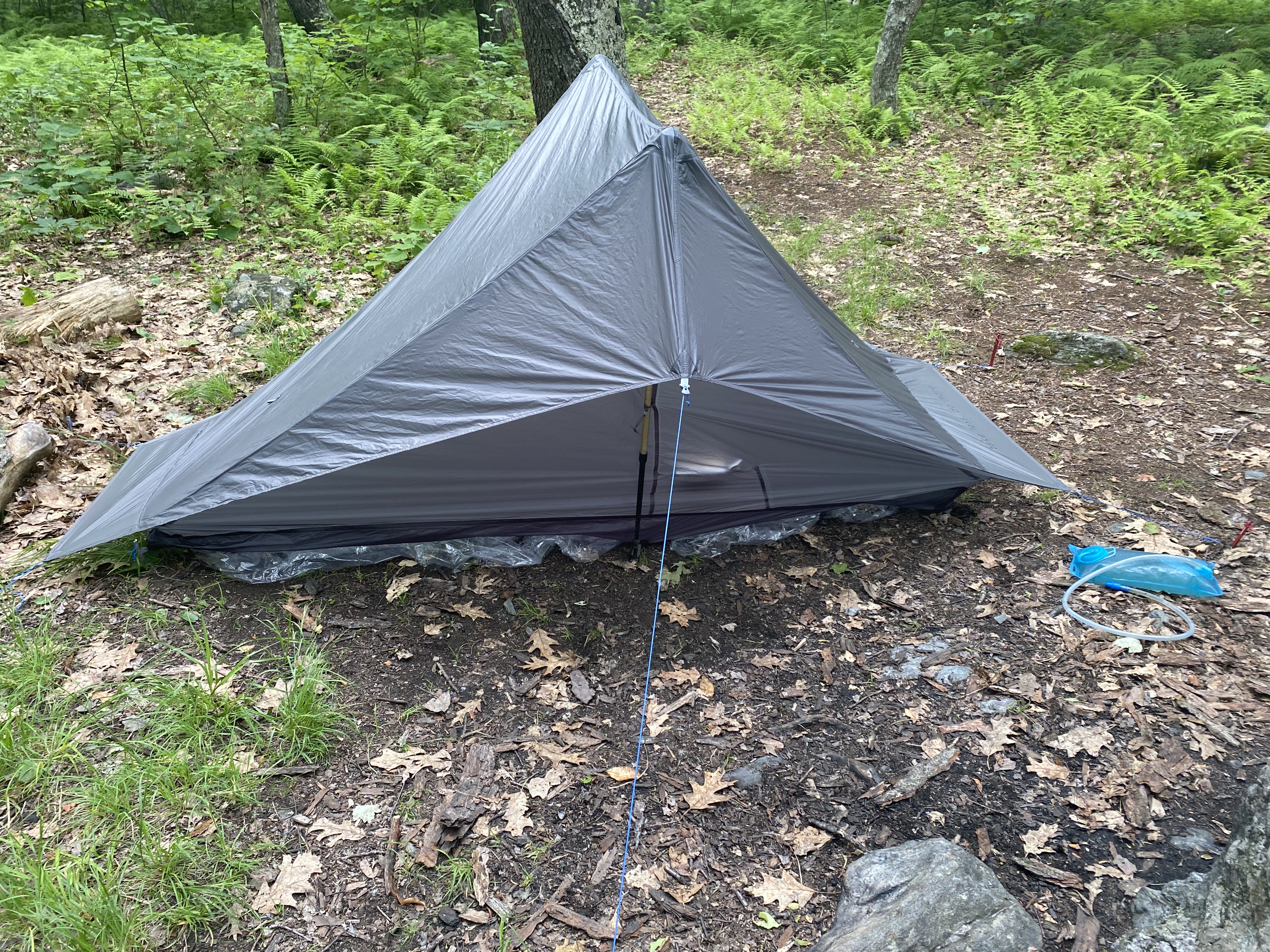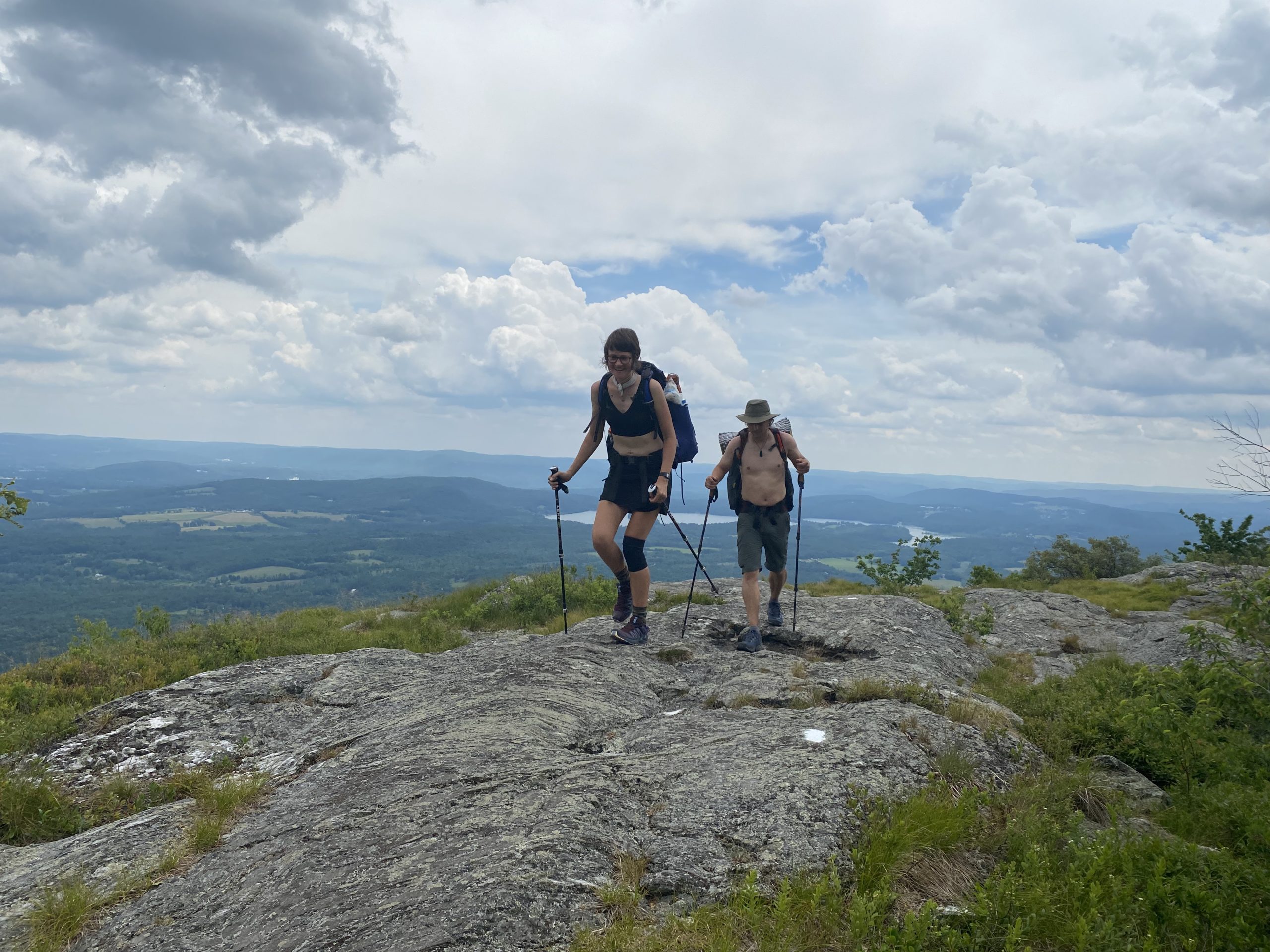So I spent a good part of last Friday today going over my gear. D. and I were heading out for our first backpacking overnight of this year’s Appalachian Trail section hiking project.
When I thru-hiked the Triple Crown back in the 1990s, gear was different, and that’s putting it mildly. Back then, the name of the game was durability, and to make gear that earned its lifetime guarantee, manufacturers used heavy-duty — emphasis on HEAVY — materials. My first Gregory pack weighed seven pounds. (I’m not guessing or misremembering. I still have it in my attic for no good reason — and I just stepped on the scale with and without it — though the dirt might have added an ounce or two.)

When I started backpacking in the 1980s, it wasn’t unusual for my pack to weight 40 – 45 pounds fully loaded, and even into the 50s on longer sections of trail. Once, on a weeklong winter ski-hike in the Tetons, it weighed north of 80 pounds and I needed help to get it on my back.) Over the years, I reduced the weight of my pack (and everything in it) significantly. But I still used mostly traditional gear.
Mom-and Pop Shops versus Traditional Makers
What I’ve learned is that much traditional gear made by big name outdoor manufacturers only goes to a certain point on the lightweight continuum. The lightest weight gear available is a sub-niche, and much of it is conceived, designed, and made by mom-and-pop cottage industries in small batches. Many of these companies don’t sell to traditional retailers: their quantities are too low, their prices too high, and the trade-offs in durability — and sometimes also in functionality, flexibility, and comfort – mean that their target markets are limited to a smaller cohort.

I’m in that cohort of hikers for whom a serious weight-focused gear upgrade makes sense. I’m a serious, experienced hiker and I’m a 62-year old woman: age is not going to make hefting a pack up a trail any easier. There are tradeoffs in going light, but I decided that my sweet spot between durability, safety, weight, and price lies somewhere other than on the continuum of what mainline manufacturers sell.
Safety and Tradeoffs in Lightweight Gear
The first step in my quest was to find out what lightweight gear really means these days. I saw plenty of manufacturers touting the terms lightweight and ultralight, but when I dug into the tech specs, I realized that these words have no meaning: They could mean 3 pounds or 1 pound — a difference of 300 percent! I needed numbers, not words.
Once I had the numbers, I looked at functionality. What was I giving up if I opted for that one-pound tent? Space? Stability? Ventilation? A floor and a mosquito net?
More questions: Do I even need a sleeping bag for summer, or would a quilt be a better choice? How much should it weigh? Same with air mattresses. My old self-inflating Thermarest weighed at least a pound and a half; the new Uber isn’t self-inflating — but it weighs only 8.8 ounces. The tradeoffs were durable materials and convenience. What were those worth to me in pound-penalties?
I used to be able to throw my six- or seven-pound Gregory pack down on the ground and sit on it without a thought. With the much more delicate-looking Golite pack I am currently using, I carefully place it on the ground, and find a rock to sit on.
Safety is another issue: I’m a firm believer in skills first. Using lightweight gear and carrying minimal redundancy equipment means having solid skills and outdoor judgment, particularly about terrain, exertion, your own fitness, navigation, and weather. If you’re considering lightening up — especially to the point where your base weight is in the 8 – 12 pound range — you’ll want to take it one step at a time. Maybe start by cutting back on or lightening your cooking equipment. Experiment with different shelter systems, depending on terrain and weather: hammocks, tarps, tarp-tents, and ultralight tents all have their cheering sections. Slowly upgrade heavy old stuff and trade in for lighter (and more compact) new stuff. Finally, experiment in areas where either the weather isn’t diabolical, or where you can bail out if the unexpected happens.
Lightweight Gear and Price
The old adage has it right: “Time, Quality, Price: Pick the two you want.” With gear, it’s “Durability, Weight, Price: Pick any two.”
So a word about price: There are bargains to be had at Walmart, on Ebay, and through hiker swaps facilitated by Facebook groups and in-person hiking groups. If you know what you want and are willing to spend the time, those are some avenues to explore.
But new high-tech equipment using the latest materials, designed and made by small businesses, can be pricey. There’s no getting around the realities of budgets: Things cost what they cost, and the numbers in our bank accounts are also fixed. My own experience is that gear, when well-maintained, lasts a heck of a long time. It’s not hard to spend a couple of thousand dollars on new top-of-the-line hiking gear — but amortized over several years, that investment pays for quite a few vacations. It’s still cheaper than a cruise, or Disneyworld, or even a week in an AirBnb somewhere.
Please note: I paid for everything named here. I have in the past received gear to review from manufacturers, and I may accept such gear in the future, but for right now, I researched and chose each piece here based on tech specs, weight, reputation, discussions with other hikers, and my own experiences and preferences. So I’ll start my reviews by looking at what I spent my own money on — and what it got me.
The Weight Savings
When I started backpacking, my pack’s base weight was somewhere near 30 pounds. (That’s not counting food and water). I’ve whittled it down over the years until today,, when it’s sitting at around 12-13 pounds (details on that to come: I’m working out some kinks).
I haven’t weighed everything yet piece by piece. Specific weights for each piece of gear will come with the individual reviews, but if I wait till I weigh everything, this will never get posted.
The LightWeight Gear List
Below is my current list of absolutely everything on my body and in my pack — not counting food and water — for summer below-treeline hiking in warm seasons.
- SLEEPING
- Gossamer Gear “The One” Tent, including stakes and cord
- Thermarest Uberlite inflatable sleeping pad
- Polycryo groundcloth (from Gossamer Gear)
- Enlightened Equipment Enigma Custom 30-degree Sleeping Quilt
- EATING
- Stove MSR Pocket Rocket
- MSR propane-butane fuel canister
- Titanium pot, barely big enough to heat 3 cups of water at a time,
- Eating utensils (titanium knife-fork combo)
- Titanium cup for coffee and soup.
- Pot grabber
- Pot cleaner
- Matches and/or lighter
- Garbage bag (gallon zip lock)
- Ursack and caribiner for bear-resistant food storage
- Water filter: Sawyer mini with plunger to clean it
- Backup water treatment: Either iodine pills or aquamira.
- 1 liter water bottle (store bought water)
- Sawyer 1-pint water bag
- 4–liter MSR water bag for camp.
- CLOTHING I WEAR
- Merino T-shirt
- Northface shorts
- Icebreaker Merino bra
- Jockey Traveler underwear
- Polyprophylen sock liners
- Darn tough midweight hiking socks
- Salomon or Dirty Girl Gaiters.
- Tilly Hat
- CLOTHING IN PACK
- 1 extra pair underwear
- Extra socks and liners (if out for more than one night)
- Ibex Merino lightweight leggings (for sleeping or unexpected cold)
- Ibex Merino lightweight long-sleeved shirt (for sleeping or unexpected cold)
- Smartwool Merino shorts (for sleeping if it’s warm, swimming, backup shorts)
- Woolx Merino T (if out for more than one night; for sleeping in war,m weather and for back-up)
- O.R. (Outdoor Research) Helium 2 Rain jacket
- Lightweight Patagonia puffy jacket
- Flip flops, Crocs, or water slippers for camp shoes
- CLOTHING ADDED FOR ALPINE AREAS OR COLDER SEASONS
- O.R. Helium rainpants.
- Switch out the light Patagonia jacket for a warmer one
- Switch out lightweight merino base layers for mid-weight merino
- CARRYING
- Leki shock absorbing Makalu trekking poles (also used to hold up tent)
- THINGS TO HAVE HANDY WHILE WALKING. Note: The following items are carried in: a waist pack, a shoulder pouch, or in zip pockets on the pack waist belt. Also, there is a strap pouch for carrying water so I don’t have to take off my pack to drink.
- Phone/camera
- Glasses, sunglasses
- Bug stuff
- Lip balm
- Map/guide (sheets of paper for section being hiked, not whole books)
- Sunscreen
- Mini Swiss army knife
- Sawyer water filter
- Small amount of toilet paper
- Mask
- DITTY BAG for Daily Camp
- Comb
- Mini container of Liquid Soap (Dr. Brommers)
- Toothbrush/toothpaste/flossers
- TP
- Daily vitamins/medications
- Hydrocortisone cream (bug bites)
- Qtips
- Spare Matches
- Lightload towel
- Pen and tiny notebook
- DITTY BAG for emergency and back-up items (not expected to be needed every day).
- First aid and blister kit (tape, moleskin, bandaids, Second skin, tweezers. Meds: claritin, advil, cold meds, stomach meds, antibiotic ointment, rubbing alcohol, cough lozenges
- Nail clipper
- Battery charger/cable
- Backup/extra matches
- Extra tp
- Money, license, health insurance card, and credit cards
I’ll be following up with updates on what I change out, and reviews of what I’m using on both our day hikes, as well as the upcoming overnights. In the next few days and weeks, look for posts about the Altra Lone Peak trail runners, the Woolx merino shirt (Inquiring minds want to know just exactly what odor-resistant means in a hiking shirt — just how many days can I hike without washing it before D. won’t let me into her car? ), MSR gaiters, Northface shorts, the Gossamer Gear solo tent, as well as water carrying and filtering choices, trekking poles, sock systems, and more.
